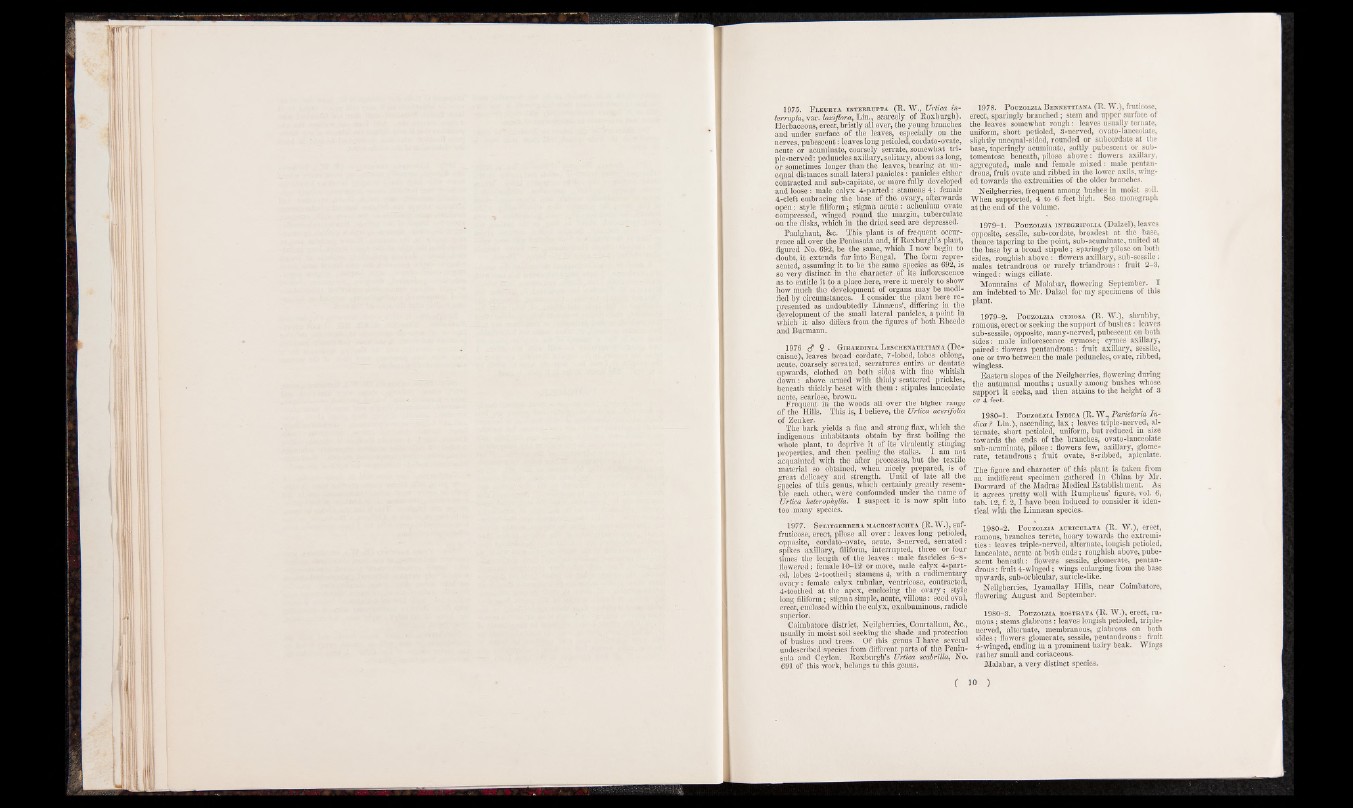
1975. F leurya interrupt a (R. W ., Urtica in-
terrupta, var. laxijiora, Lin., scarcely of Roxburgh).
Herbaceous, erect, bristly all over, the young branches
and under surface of the leaves, especially on the
nerves, pubescent: leaves long petioled, cordato-ovate,
acute or acuminate, coarsely serrate, somewhat triple
nerved: peduncles axillary, solitary, about as long,
or sometimes longer than the leaves, bearing a t unequal
distances small lateral panicles: panicles either
contracted and sub-capitate, or more fully developed
and loose : male calyx 4-parted: stamens 4: female
4-cleft embracing the base of the ovary, afterwards
open: style filiform; stigma acute: achenium ovate
compressed, winged round the margin, tuberculate
on the disks, which in the dried seed are depressed.
Paulghaut, &c. This plant is of frequent occurrence
all over the Peninsula and, if Roxburgh’s plant,
figured No. 692, be the same, which I now begin to
doubt, it extends far into Bengal. The_ form represented,
assuming it to be the same species as 692, is
so very distinct in the character of its inflorescence
as to entitle it to a place here, were it merely to show
how much the development of organs may be modified
by circumstances. I consider the plant here represented
as undoubtedly Linnaeus’, differing in the
development of the small lateral panicles, a point in
which it also differs from the figures of both Rheede
and Burmann.
1976 cT $ • Girardinia L eschenaultiana (De-
caisne), leaves broad/ cordate, 7-lobed, lobes oblong,
acute, coarsely serrated, serratures entire or dentate
upwards, clothed on both sides with fine whitish
down: above armed with thinly scattered prickles,
beneath thickly beset with them: stipules lanceolate
acute, scariose, brown.
Frequent in the woods all over the higher range
of the Hills. This is, I believe, the Urtica acerifolia
of Zenker.
The bark yields a fine and strong flax, which the
indigenous inhabitants obtain by first boiling the
whole plant, to deprive it of its virulently stinging
properties, and then peeling the stalks. I am not
acquainted with the after processes, but the textile
material so obtained, when nicely prepared, is of
great delicacy and strength. Until of late all the
species of this genus, which certainly greatly resemble
each other, were confounded under the name of
Urtica heterophytta. I suspect it is now split into
too many species.
1977. S plitgerbera macrostachya (R. W.), suf-
fruticose, erect, pilose all over: leaves long petioled,
opposite, cordato-ovate, acute, 3-nerved, serrated:
spikes axillary, filiform, interrupted, three or four
times the length of the leaves: male fascicles 6-8-
flowered; female 10-12 or more, male calyx 4-parted,
lobes 2-toothed; stamens4, with a rudimentary
ovary: female calyx tubular, ventricose, contracted,
4-toothed at the apex, enclosing the ovary; style
long filiform; stigma simple, acute, villous: seed oval,
erect, enclosed within the calyx, exalbuminous, radicle
superior.
Coimbatore district, Neilgherries, Courtallum, &c.,
usually in moist soil seeking the shade and protection
of bushes and trees. Of this genus I have several
undescribcd species from different parts of the Peninsula
and Ceylon. Roxburgh’s Urtica scabrilla, No.
691 of this work, belongs to this genus.
1978. P ouzolzia Bennettiana (R. W .), fruticose,
erect, sparingly branched; stem and upper surface of
the leaves somewhat rough: leaves usually ternate,
uniform, short petioled, 3-nerved, ovato-lanceolate,
slightly unequal-sided, rounded or subcordate at the
base, taperingly acuminate, softly pubescent or sub-
tomentose beneath, pilose above: flowers axillary,
aggregated, male and female mixed: male pentan-
drous, fruit ovate and ribbed in the lower axils, winged
towards the extremities of the older branches.
Neilgherries, frequent among bushes in moist soil.
When supported, 4 to 6 feet high. See monograph
at the end of the volume.
1979-1. P ouzolzia integrifolia (Dalzel), leaves
opposite, sessile, sub-cordate, broadest at the_ base,
thence tapering to the point, sub-acuminate, united at
the base by a broad stipule; sparingly pilose on both
sides, roughish above : flowers axillary, sub-sessile;
males tetrandrous or rarely triandrous: fruit 2-3,
winged: wings ciliate.
Mountains of Malabar, flowering September. I
am indebted to Mr. Dalzel for my specimens of this
plant.
1979- 2. P ouzolzia cymosa (R. W.), shrubby,
ramous, erect or seeking the support of bushes: leaves
sub-sessile, opposite, many-nerved, pubescent on both
sides: male inflorescence cymose; cymes axillary,
paired: flowers pentandrous: fruit axillary, sessile,
one or two between the male peduncles, ovate, ribbed,
wingless.
Eastern slopes of the Neilgherries, flowering during
the autumnal months; usually among bushes whose
support it seeks, and then attains to the height of 3
or 4 feet.
1980- 1. P ouzolzia I ndica (R. W., Parietaria In-
dica? Lin.), ascending, la x ; leaves triple-nerved, alternate,
short petioled, uniform, but reduced in size
towards the ends of the branches, ovato-lanceolate
sub-acuminate, pilose: flowers few, axillary, glomerate,
tetandrous; fruit ovate, 8-ribbed, apiculate.
The figure and character of this plant is taken from
an indifferent specimen gathered in China by Mr.
Dorward of the Madras Medical Establishment. As
it agrees pretty well with Rumpheus’ figure, vol. 6,
tab. 12, f. 2 , 1 have been induced to consider it identical
with the Linnajan species.
1980-2. P ouzolzia auriculata (R. W.), erect,
ramous, branches terete, hoary towards the extremities
: leaves triple-nerved, alternate, longish petioled,
lanceolate, acute at both ends; roughish above, pubescent
beneath: flowers sessile, glomerate, pentandrous
: fruit 4-winged; wings enlarging from the base
upwards, sub-orbicular, auricle-like.
Neilgherries, Iyamallay Hills, near Coimbatore,
flowering August and September;
1980-3. P ouzolzia rostrata (R. W.), erect, ramous
; stems glabrous: leaves longish petioled, triple-
nerved, alternate, membranous, glabrous on both
sides; flowers glomerate, sessile, pentandrous: fruit
4-winged, ending in a prominent hairy beak. Wings
rather small and coriaceous.
Malabar, a very distinct species.